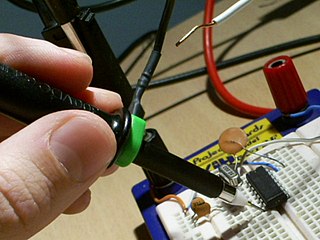Related Research Articles

An operational amplifier is a DC-coupled electronic voltage amplifier with a differential input, a (usually) single-ended output, and an extremely high gain. Its name comes from its original use of performing mathematical operations in analog computers.
SPICE is a general-purpose, open-source analog electronic circuit simulator. It is a program used in integrated circuit and board-level design to check the integrity of circuit designs and to predict circuit behavior.

In electronics, emitter-coupled logic (ECL) is a high-speed integrated circuit bipolar transistor logic family. ECL uses an overdriven bipolar junction transistor (BJT) differential amplifier with single-ended input and limited emitter current to avoid the saturated region of operation and the resulting slow turn-off behavior. As the current is steered between two legs of an emitter-coupled pair, ECL is sometimes called current-steering logic (CSL), current-mode logic (CML) or current-switch emitter-follower (CSEF) logic.

A power supply is an electrical device that supplies electric power to an electrical load. The main purpose of a power supply is to convert electric current from a source to the correct voltage, current, and frequency to power the load. As a result, power supplies are sometimes referred to as electric power converters. Some power supplies are separate standalone pieces of equipment, while others are built into the load appliances that they power. Examples of the latter include power supplies found in desktop computers and consumer electronics devices. Other functions that power supplies may perform include limiting the current drawn by the load to safe levels, shutting off the current in the event of an electrical fault, power conditioning to prevent electronic noise or voltage surges on the input from reaching the load, power-factor correction, and storing energy so it can continue to power the load in the event of a temporary interruption in the source power.

A switched-mode power supply (SMPS), also called switching-mode power supply, switch-mode power supply, switched power supply, or simply switcher, is an electronic power supply that incorporates a switching regulator to convert electrical power efficiently.
This is an index of articles relating to electronics and electricity or natural electricity and things that run on electricity and things that use or conduct electricity.

An instrumentation amplifier is a type of differential amplifier that has been outfitted with input buffer amplifiers, which eliminate the need for input impedance matching and thus make the amplifier particularly suitable for use in measurement and test equipment. Additional characteristics include very low DC offset, low drift, low noise, very high open-loop gain, very high common-mode rejection ratio, and very high input impedances. Instrumentation amplifiers are used where great accuracy and stability of the circuit both short- and long-term are required.

A differential amplifier is a type of electronic amplifier that amplifies the difference between two input voltages but suppresses any voltage common to the two inputs. It is an analog circuit with two inputs and and one output , in which the output is ideally proportional to the difference between the two voltages:

An active filter is a type of analog circuit implementing an electronic filter using active components, typically an amplifier. Amplifiers included in a filter design can be used to improve the cost, performance and predictability of a filter.

A traveling-wave tube or traveling-wave tube amplifier is a specialized vacuum tube that is used in electronics to amplify radio frequency (RF) signals in the microwave range. It was invented by Andrei Haeff around 1933 as a graduate student at Caltech, and its present form was invented by Rudolf Kompfner in 1942–43. The TWT belongs to a category of "linear beam" tubes, such as the klystron, in which the radio wave is amplified by absorbing power from a beam of electrons as it passes down the tube. Although there are various types of TWT, two major categories are:

A voltage regulator is a system designed to automatically maintain a constant voltage. It may use a simple feed-forward design or may include negative feedback. It may use an electromechanical mechanism, or electronic components. Depending on the design, it may be used to regulate one or more AC or DC voltages.

In electronics, a choke is an inductor used to block higher-frequency alternating currents (AC) while passing direct current (DC) and lower-frequency ACs in a circuit. A choke usually consists of a coil of insulated wire often wound on a magnetic core, although some consist of a doughnut-shaped ferrite bead strung on a wire. The choke's impedance increases with frequency. Its low electrical resistance passes both AC and DC with little power loss, but its reactance limits the amount of AC passed.

Quite Universal Circuit Simulator (Qucs) is a free-software electronics circuit simulator software application released under GPL. It offers the ability to set up a circuit with a graphical user interface and simulate the large-signal, small-signal and noise behaviour of the circuit. Pure digital simulations are also supported using VHDL and/or Verilog. Only a small set of digital devices like flip flops and logic gates can be used with analog circuits. Qucs uses its own SPICE-incompatible backend simulator Qucsator, however the Qucs-S fork supports some SPICE backends.

A test probe is a physical device used to connect electronic test equipment to a device under test (DUT). Test probes range from very simple, robust devices to complex probes that are sophisticated, expensive, and fragile. Specific types include test prods, oscilloscope probes and current probes. A test probe is often supplied as a test lead, which includes the probe, cable and terminating connector.
A direct-coupled amplifier or DC amplifier is a type of amplifier in which the output of one stage of the amplifier is coupled to the input of the next stage in such a way as to permit signals with zero frequency, also referred to as direct current, to pass from input to output. This is an application of the more general direct coupling. It was invented by Harold J Paz and Francis P. Keiper Jr. in 1955. It displaced the triode vacuum tube amplifier designed by Lee de Forest. Almost all vacuum tube circuit designs are now replaced with direct coupled transistor circuit design. It is the first transistor amplifier design that did not include coupling capacitors. The direct-coupled amplifier allowed analog circuits to be built smaller with the elimination of coupling capacitors and removed the lower frequency limitation that is dependent on capacitors.
Technical specifications and detailed information on the valve audio amplifier, including its development history.
LTspice is a SPICE-based analog electronic circuit simulator computer software, produced by semiconductor manufacturer Analog Devices. It is the most widely distributed and used SPICE software in the industry. Though it is freeware, LTspice is not artificially restricted to limit its capabilities. It ships with a library of SPICE models from Analog Devices, Linear Technology, Maxim Integrated, and third-party sources.

A microchannel plate (MCP) is used to detect single particles and photons. It is closely related to an electron multiplier, as both intensify single particles or photons by the multiplication of electrons via secondary emission. Because a microchannel plate detector has many separate channels, it can provide spatial resolution.

The field-effect transistor (FET) is a type of transistor that uses an electric field to control the flow of current in a semiconductor. It comes in two types: junction FET (JFET) and metal-oxide-semiconductor FET (MOSFET). FETs have three terminals: source, gate, and drain. FETs control the flow of current by the application of a voltage to the gate, which in turn alters the conductivity between the drain and source.
A voltage-controlled resistor (VCR) is a three-terminal active device with one input port and two output ports. The input-port voltage controls the value of the resistor between the output ports. VCRs are most often built with field-effect transistors (FETs). Two types of FETs are often used: the JFET and the MOSFET. There are both floating voltage-controlled resistors and grounded voltage-controlled resistors. Floating VCRs can be placed between two passive or active components. Grounded VCRs, the more common and less complicated design, require that one port of the voltage-controlled resistor be grounded.
References
- 1 2 U.S. Patent 7502723.: "Asymmetric minor hysteresis loop model and circuit simulator including the same", filed September 1, 2005.
- 1 2 3 4 5 6 "LTspice Genealogy – The Heritage of Simulation Ubiquity". LTwiki. Archived from the original on December 2, 2018.
- 1 2 Engelhardt, Mike (January 2015). "SPICE Differentiation" (PDF). LT Journal of Analog Innovation. Linear Technology: 7 pages. Archived (PDF) from the original on May 17, 2018.
- 1 2 "Re-writing SPICE for a digital world". EE News Power. May 10, 2023. Archived from the original on May 14, 2023.
- 1 2 3 Mike Engelhardt; LinkedIn.
- ↑ Engelhardt, Mike (March 1992). "Design and Characteristics of a Lens Spectrometer with Electrostatic Extraction for Electron Beam Probing". Microelectronic Engineering. Elsevier: 6 pages.
- ↑ Engelhardt, Mike (February 1996). "Design and Characteristics of a Magnetic Collimating Lens Spectrometer for Electron Beam Probing". Microelectronic Engineering. Elsevier: 6 pages.
- ↑ "Soft X-Ray Photoemission with the SSX-100 Spectrometer". Nuclear Instruments and Methods in Physics Research. Elsevier: 4 pages. May 1986.
- ↑ U.S. Patent 8686702.: "Negative slope compensation for current mode switching power supply", filed February 15, 2012.
- ↑ U.S. Patent 10637254.: "Spread spectrum for switch mode power supplies", filed September 29, 2015.
- ↑ U.S. Patent 9866245.: "Active differential resistors with reduced noise", filed August 12, 2016.
- ↑ U.S. Patent 10218394.: "Active differential resistors with reduced noise", filed December 6, 2017.
- ↑ U.S. Patent 8274266.: "Switch mode power supply with dynamic topology", filed August 14, 2009.
- ↑ U.S. Patent 9966832.: "Predictive ripple-cancelling signal into error amplifier of switch mode power supply", filed May 9, 2017.
- ↑ U.S. Patent 10270330.: "Predictive ripple-cancelling signal into error amplifier of switch mode power supply", filed May 3, 2018.